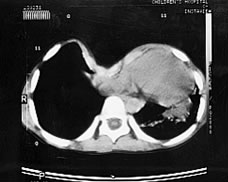
Pectus Excavatum
What is pectus excavatum?
Pectus excavatum (also called funnel chest) is a congenital chest wall deformity in which the sternum (breastbone) and adjacent ribs are abnormally sunken inward, giving the chest a concave or “dipped” appearance.
Cause: It results from abnormal growth of the costal cartilages that connect the ribs to the sternum.
Severity: The depression can range from mild to severe. In severe cases, the inward displacement can compress the heart and lungs, leading to symptoms such as shortness of breath, reduced exercise tolerance, or palpitations.
Appearance: Patients often have a slender chest, forward-slouching posture, and protruding abdomen (especially in children). The deformity can be symmetric or asymmetric, and the sternum may be rotated.
Epidemiology: It occurs in about 1 in 400 births, with a male-to-female ratio of about 4:1.
Associated conditions: It can occur with other connective tissue disorders such as Marfan syndrome or Ehlers-Danlos syndrome.
Treatment: Mild cases may be managed with physical therapy or posture exercises, while moderate to severe cases may require surgical correction (e.g., Nuss procedure or Ravitch procedure).
Does the deformity become worse over time?
Early appearance: The depression of the sternum is often visible at birth or within the first few months of life.
Progression: The deformity tends to worsen gradually during childhood, becoming most pronounced during the adolescent growth spurt (around ages 11–15). This is when the chest wall grows rapidly, and the abnormal costal cartilage growth can exaggerate the sunken appearance.
Stabilization: After skeletal maturity (around 18 years of age), the chest wall hardens, and the deformity usually stabilizes — meaning it doesn’t continue to worsen structurally.
Adult changes: Although the shape of the chest doesn’t typically progress after maturity, symptoms may increase with age in some people. This can happen because the compressed chest cavity affects heart and lung function more as the body ages, or because posture and muscle tone change over time.
In adults, weight gain, muscle development, or chest hair (in men) can make the deformity less noticeable, though the underlying structure remains the same.
Will exercise and weight training improve pectus excavatum?
Exercise will not cure pectus excavatum, but it can improve poor posture and may slow the progression of mild to moderate conditions. Regular exercise can also lessen problems with breathing or exercise stamina. We certainly encourage physical therapy after the Nuss procedure and living a healthy, active lifestyle.




